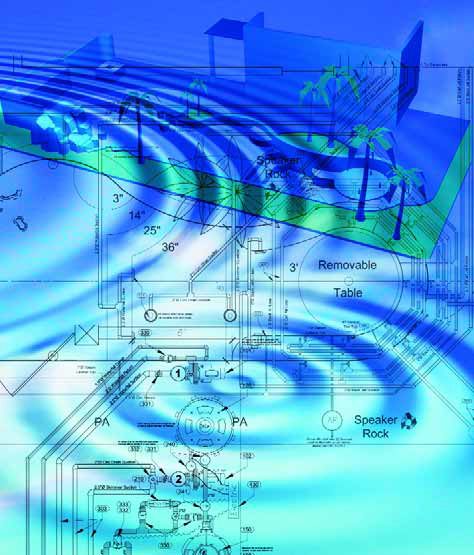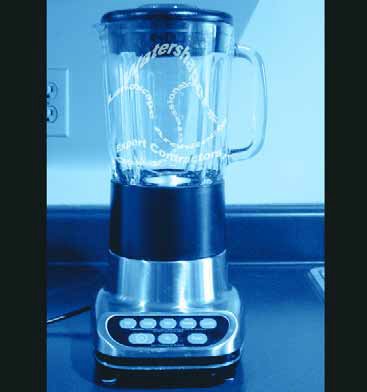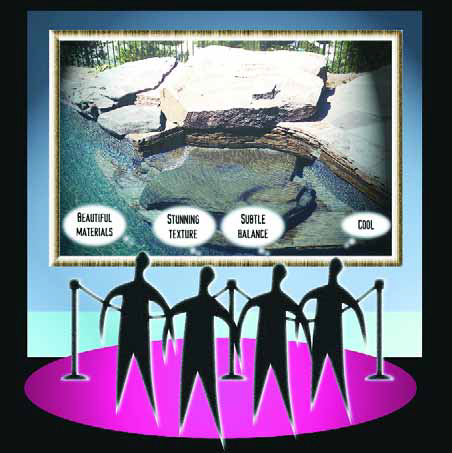watershape design
What do you see when you look at postcards, ads and travel posters designed to lure you to exotic, sunny locations? Almost without exception, there are palms - the omnipresent invitation to experience all things tropical. The association is so close, in fact, that it's hard to imagine a tropical resort or lagoon-style backyard pool without at least one of them in sight. The allure of palms, of course, extends well beyond the tropics. In any location in which sunshine and outdoor living are touchstones for the good life, whether its in the desert of southern California or on a waterfront in Hawaii, palms are almost always the finishing touch used in crafting a distinctive artistic and cultural statement. They are the icons of
What do you see when you look at postcards, ads and travel posters designed to lure you to exotic, sunny locations? Almost without exception, there are palms - the omnipresent invitation to experience all things tropical. The association is so close, in fact, that it's hard to imagine a tropical resort or lagoon-style backyard pool without at least one of them in sight. The allure of palms, of course, extends well beyond the tropics. In any location in which sunshine and outdoor living are touchstones for the good life, whether its in the desert of southern California or on a waterfront in Hawaii, palms are almost always the finishing touch used in crafting a distinctive artistic and cultural statement. They are the icons of
Why isn't the appropriate use of water a defining, central component in the education of landscape architects? That question has rattled around in my head for a long, long time, basically because it has no adequate or satisfactory answer. I'm a trained landscape architect and, as luck would have it, for nearly 20 years I've had one foot in the pool industry and the other in landscape architecture - and I've always felt like a rare beast moving back and forth between two entirely separate worlds. As I see it, this lack of affinity between these water-related industries has been a limiting factor in the advancement of the watershaping trades. For me, the lack of connection has always seemed nonsensical when it hasn't seemed tragic. As a watershaper, a big part of my work in recent years has been seeking ways to combine the best of both worlds and share what I know with university-level students in landscape architecture departments - students whose chairs I occupied some years ago and who still stand a good chance of graduating without ever having been taught anything at all about how water can
Why isn't the appropriate use of water a defining, central component in the education of landscape architects? That question has rattled around in my head for a long, long time, basically because it has no adequate or satisfactory answer. I'm a trained landscape architect and, as luck would have it, for nearly 20 years I've had one foot in the pool industry and the other in landscape architecture - and I've always felt like a rare beast moving back and forth between two entirely separate worlds. As I see it, this lack of affinity between these water-related industries has been a limiting factor in the advancement of the watershaping trades. For me, the lack of connection has always seemed nonsensical when it hasn't seemed tragic. As a watershaper, a big part of my work in recent years has been seeking ways to combine the best of both worlds and share what I know with university-level students in landscape architecture departments - students whose chairs I occupied some years ago and who still stand a good chance of graduating without ever having been taught anything at all about how water can
The history of residential architecture took a real turn toward mass production with the emergence of the modern suburb early in the 20th Century. Especially in the years after World War II, middleclass families increasingly left urban congestion behind and headed for open outlying areas where developers were hard at work in preparation for their arrival. Some developers put distinct stylistic stamps on the neighborhoods and communities they were building. Among the most popular and recognizable of these styles was the Spanish Colonial Revival - a look that has special prominence on the West Coast but that has surfaced throughout the United States and in places as far flung as Europe and China. This style is so popular and has been used so much in so many variations that it is, these days, tough to nail down exactly what is or is not true to early Spanish Colonial motifs and ideas. That's not surprising, because this malleable style itself represents a cobbling together of ideas borrowed from Roman, Islamic and even Native American cultures. Those deep roots, coupled with a scattering of design focus that has blurred borders and distinctions and any sense of stylistic purity, makes it tough for 21st-century watershapers and other designers to
Natural stone is certainly the most time-honored of all building materials. From the pyramids of Egypt to the temples and civic buildings of ancient Greece and Rome; from the palaces and villas of the Renaissance to the most contemporary structures of our modern era, we see a material forged within the earth for millions of years that has been painstakingly quarried and shaped into myriad forms both functional and decorative. Even with the advent of cementitious components and a range of other manufactured substitutes, stone remains the material of choice in a great many applications. In fact, the range of natural stone materials available to designers and builders expands almost daily in response to the specific demands of watershapers and other designers and contractors - and there's no end in sight. Our company, tr stone, is a U.S. distribution facility owned and operated by one of the world's largest stone producers, Tureks, based in Afyon, Turkey. The best thing about the marketplace from the perspective of designers and builders is that high-quality stone is now available from a wide range of domestic and foreign sources in a number of distinctive
'The way a team plays as a whole determines its success. You may have the greatest bunch of individual stars in the world, but if they don't play together, the club won't be worth a dime.' -- Babe Ruth How many watershaping projects are
Of all the concepts of hydraulic-system design, there are few that have more importance than the correlation between water flow (that is, capacity expressed as gallons per minute) and line velocity (the speed at which the water travels). As water travels through a pipe, its increase in speed (that is, its line velocity) results in an increase in resistance (expressed as feet of head) and in a reduction of end pressure, which is measured in pounds per square inch (psi). In other words, an increase in friction losses and a drop in pressure is the result of increased water velocity at a given flow. If that makes sense to you without further explanation, then you know much of what you need to know when it comes to selecting pipes and fittings and setting up a watershape's plumbing system. If it doesn't, this article will cover the basics - from selecting pipes and sizing lines to
In one way or another, visual acceptance is what makes our world go around. Think about the clothes we wear, the cars we admire, the foods we eat - not to mention interior design, home and office furnishings, landscapes and watershapes. So much of our response to these and other features of our environment is based on the visual. It may sometimes be a shallow response, but human beings tend to like things that look good, even if they don't completely understand why some things are visually appealing and others are not. Design education teaches us that




















